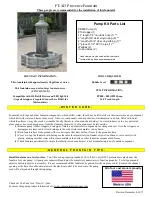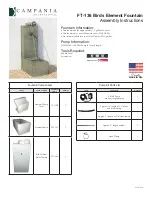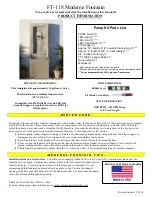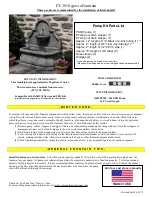
Campania International - Fountain Guide
Set-up
Assembly & Installation
A fountain can be difficult to install without knowing and understanding the steps involved. To ensure your
fountain is installed properly, please read our instructions and tips before you begin.
1.
Seek Professional Help:
Check if professional installation is recommended for your fountain.
2.
Check Foundation:
Place your fountain on a level surface. It is recommended to place your fountain on
concrete or a hard packed gravel pad. If the base is level but some components seem off, rotate components
or use wedges to level them.
3.
Create a Drip Loop:
To prevent water from dripping down the cord and damaging the electrical socket,
create a drip loop by allowing the pump power cord to fall below the wall outlet.
4.
Use a GFCI Outlet:
Use only a GFCI outlet when running a fountain.
Maintenance
Pump Care
The fountain relies heavily on the quality of the pump. A well-maintained pump can last several years.
1.
Fully Submerge:
Ensure the pump is fully submerged at all times to avoid damage.
2.
Ensure Water Level is Sufficient:
Check water levels regularly as water may evaporate over time, and
periodically change water to avoid algae buildup.
3.
Clean Pump:
Use soap and water, or white vinegar and water, with a small, soft brush to clean the pump of
debris, dirt, and algae buildup. This should be done every 2-3 months.
Surface Care
Paints and finishes may fade over time due to weathering. By following these tips, you will be able to maintain
your fountain’s surface.
1.
Control Algae and White Scale:
Due to water evaporation, you may see white residue on your fountain
surface from the mineral content in your water supply. Algaecides and cleansers can help prevent buildup
that occurs from minerals and hard water.
2.
Protect and Refinish:
Depending on the material of your fountain, protectants and sprays may prolong the
appearance of the surface. Paint and refinishing kits can be used for touch-up.
Winter Care
Cast stone can expand and contract in different temperatures/humidity levels. If the temperature falls below
32°F or humidity levels change drastically, follow the steps below to protect your fountain.
1.
Bring Inside:
If possible, bring your outdoor fountain inside for the winter.
2.
Store in Dry Location:
If unable to bring inside, store your fountain in a dry and covered location.
3.
Bring Components Inside:
Move all internal components (stoppers, tubing, lights, pump, etc.) inside.
A pump can stay in a fountain for the winter, but if you choose to leave it in, it must be completely dry and
insulated with plastic bags and towel to ensure it stays dry. However it is recommended to bring it inside.
4.
Completely Drain:
It is important to prevent water from accumulating anywhere, as freezing and thawing
of water can cause pump damage and cause cracks to form in your fountain. Remove the drain plugs.
5.
Elevate Fountain:
Fountains may freeze to the ground and cause cracking in the base if left outside in the
winter. If unable to store inside or in a dry covered location, try to raise your fountain above ground.
6.
Cover Fountain:
Contact your retailer to find the right size cover for your specific fountain. There are four
different sizes. When covering, make sure the fountain is taut so that no snow or water can pool in the
cover. Pull the string to tighten the opening of the cover around the fountain.






















